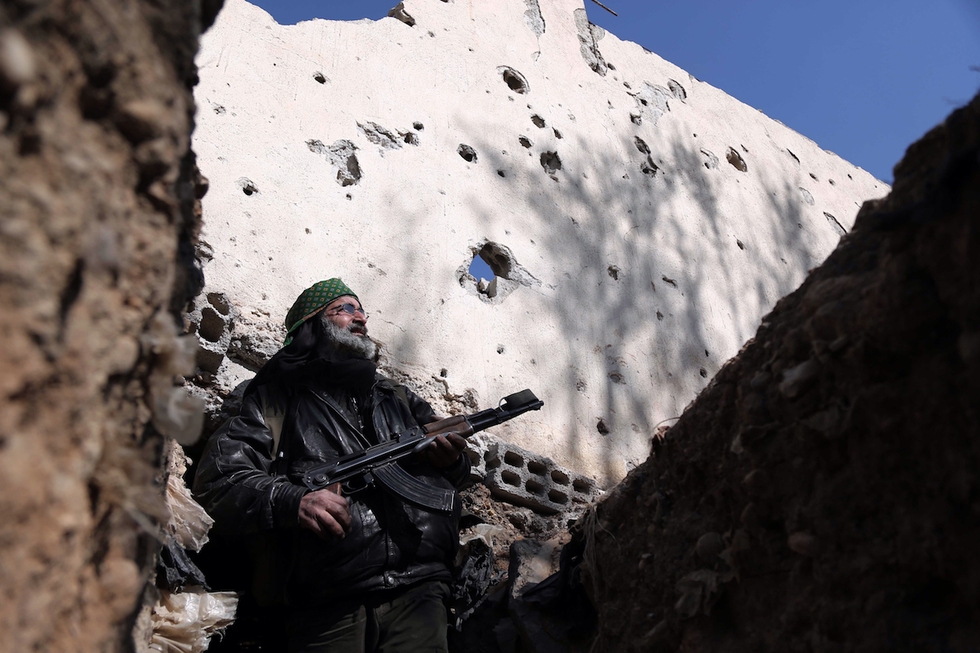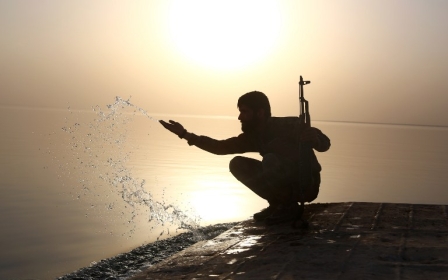Syrian rebels 'fire on protesters' calling for end to infighting

At least 95 people have been killed in five days of fighting between rival rebel groups in the Damascus suburb of Eastern Ghouta, amid reports rebels had fired on protesters calling for the clashes to stop.
Fighters from the powerful Jaish al-Islam rebel group fought against Faylaq al-Rahman after the latter rallied to the defence of Hayat Tahrir al-Sham (HTS), a coalition dominated by the former al-Qaeda affiliate Jabhat Fateh al-Sham (JFS).
More than 95 people are thought to have been killed since Jaish al-Islam launched their campaign to drive out HTS last week, fearing the coalition's encroachment on an area which as been firmly controlled by Jaish al-Isalm since 2013.
According to the Syrian Observatory for Human Rights, clashes took place late on Sunday close to Zamalka city, another suburb of Damascus which is a stronghold of Faylaq al-Rahman, a group backed by Turkey and Qatar.
A journalist from Eastern Ghouta told Al Jazeera the fighting had intensified on Monday.
"One of the main reasons behind these deadly clashes is the differences these rebel groups have," he said, on condition of anonymity.
"They have different beliefs and goals. But the infighting is affecting us because we already live under a siege. We have the government air strikes from above, a siege and fighting on the ground."
Intra-rebel fighting has flared up repeatedly in Ghouta - in May 2016, a round of violence between opposition groups in the suburb led to more than 300 deaths.
A video released on Sunday by the opposition Step News Agency purported to show Jaish al-Islam opening fire on protesters:
In the video, demonstrators can be heard to shout "shabiha" - a derogatory term originally referring to militias hired by the Syrian president, Bashar al-Assad, to suppress dissent.
The Ghouta Media Centre told Al Jazeera that the protest took place in Arbeen, with demonstrators calling for an end to the in-fighting.
The clashes have enabled forces loyal to Assad to make advances in Damascus, the majority of which is under government control.
Eastern Ghouta has an estimated population of 400,000 people and has been under partial siege since 2013.
"The Syrian government is abusing this distraction and continues to target us with air strikes. Just a while ago a child was killed in a government air strike in Hamouriya [eastern Ghouta]," said the journalist from Eastern Ghouta.
"Residents are scared another Aleppo scenario will happen to Ghouta. We are scared of being forced to leave our homes."
During the fighting, Syrian government and allied forces attacked the rebel-held district of Qaboun northwest of East Ghouta by land and air.
The Syrian government, which is backed by Russian air power and Iranian-backed militias, launched an offensive against Qaboun and neighbouring Barza, which are believed to contain supply tunnels for the besieged enclave, in February.
Government forces advanced slightly in Qaboun on Friday, the SOHR said.
"In the end, Faylaq al-Rahman and Hayat Tahrir al-Sham brought this on themselves by trying to opportunistically diminish Jaysh al-Islam’s influence in East Ghouta and now the latter might diminish their influence in Ghouta for good," wrote Josko Baric on the Syria War Daily blog.
"If Jaysh al-Islam manages to overcome Faylaq al-Rahman and Hayaat Tahrir al-Sham it will be one step closer to a dream shared by all East Ghouta based groups, complete control over East Ghouta."
More than 320,000 people have been killed since the government opened fire on demonstrators in 2011.
New MEE newsletter: Jerusalem Dispatch
Sign up to get the latest insights and analysis on Israel-Palestine, alongside Turkey Unpacked and other MEE newsletters
Middle East Eye delivers independent and unrivalled coverage and analysis of the Middle East, North Africa and beyond. To learn more about republishing this content and the associated fees, please fill out this form. More about MEE can be found here.




